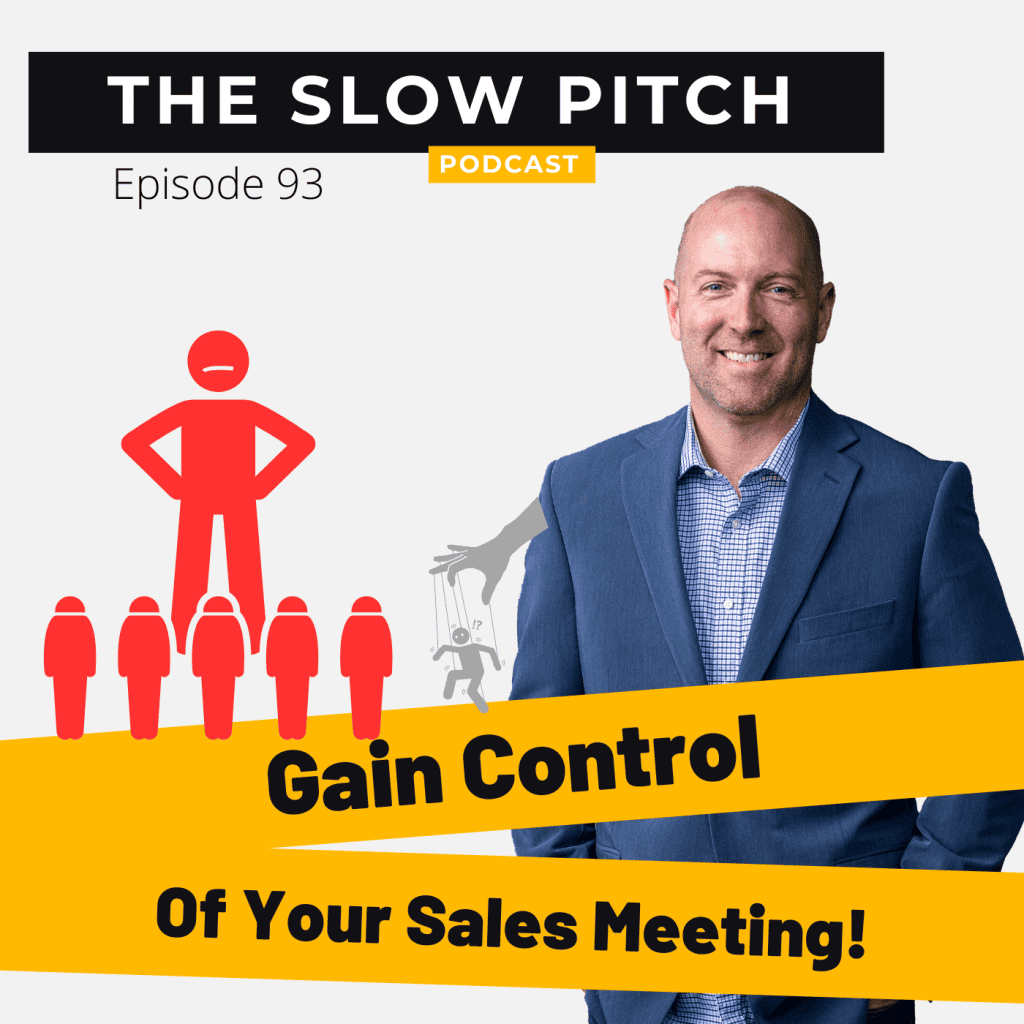Gain Control of the Sales Meeting


Notes
In this episode, Rob shares invaluable insights on how sales professionals can gain control in their sales conversations using subtle yet effective techniques inspired by a visit to the dentist. This episode is a must-listen for those looking to refine their sales approach and achieve better outcomes.
The main focus of this episode is an analogy between the actions of a dentist and the strategies of a successful salesperson. Rob recounts a recent visit to his dentist, where he observed a technique that is incredibly applicable to sales. The core idea is how the dentist keeps the patient informed about each next step, thereby maintaining control and ensuring the patient feels comfortable and understood. This principle is crucial for salespeople to gain control in their conversations and guide clients effectively.
Gain Control in Sales Conversations
- Gain Control of the Sale: Salespeople must maintain control of the conversation to avoid merely reacting to the client’s demands. This involves subtly guiding the discussion and ensuring that your agenda is addressed.
- Set Clear Expectations: Just as a dentist explains the next steps to a patient, you should inform the client about what will happen next. This technique not only sets clear expectations but also establishes you as a trusted advisor.
- Ask for Permission: Phrases like “Would you mind if I asked you a few more questions?” help in transitioning control back to the salesperson. This polite request ensures the client is comfortable and more willing to follow the your lead.
- Be Prepared with Questions: Anticipating the client’s responses and having follow-up questions ready is crucial. This preparation allows you to delve deeper into the client’s needs and uncover underlying issues or desires.
- Maintain Equality in Dialogue: Throughout the conversation, it is important to ensure that both parties feel equal. This balance fosters a collaborative environment rather than a hierarchical one, enhancing mutual respect and understanding.
- Eliminate Surprises: Ending meetings with a clear understanding of the next steps prevents surprises and ensures both parties are on the same page. This clarity reduces the likelihood of being “ghosted” by the client and keeps the sales process moving forward smoothly.
How To Apply This Information
After listening to this episode, sales professionals can implement these strategies to improve their control over sales conversations and build stronger client relationships. Here’s how to apply the key takeaways:
- Prepare Your Conversations: Before a sales meeting, outline the key points you need to cover and the questions you need to ask. This preparation will help you steer the conversation effectively.
- Set Clear Expectations: At the start of the meeting, explain the agenda and what the client can expect. This sets the tone and helps manage the client’s expectations.
- Use Transitional Phrases: Incorporate transitional phrases that gently guide the conversation. For example, “Is it okay if I explain our next steps?” helps in gaining control without being forceful.
- Equal Partnership: Treat the conversation as a partnership. Ensure that the client feels heard and respected, and position yourself as a knowledgeable advisor rather than a pushy salesperson.
- Follow-Up Clarity: End every meeting by summarizing the discussed points and clearly outlining the next steps. This practice ensures both parties leave with a clear understanding of what will happen next, reducing the risk of miscommunication.
Using these strategies you can maintain control of your conversations, set clear expectations, and build stronger, more effective relationships with your clients.
Additional Resources
Revisit past episodes, such as “Sell How People Buy,” which digs deeper into the different ego states involved in the sales process. You can also listen to What Makes A Great Salesperson? And What Makes a Good Salesperson? (How are they different?) to learn a bit more about how to separate yourself from the competition. As always, there are other resources out there related, but you can always listen to more at The Slow Pitch Sales Podcast channel on YouTube.
Podcast Recorded on Squadcast.fm
NOTE: Some links may be affiliate links, which means we get paid a commission when you purchase, but it the cost remains the same for you.
Music: "Clydesdale Funk" by Cast of Characters, written by: Dustin Ransom.
The Episode
Rob 00:04
All right, welcome back, everybody. And today we’re talking about salespeople that are so good, you don’t even know they’re selling. And a good example of that is your dentist.
Rob 00:14
But before we get started, I just want to remind everybody who I am, what I do, and all that good stuff, because I don’t see this very often. And it’s typically because of this show is not about me, it’s about helping you and getting the most out of it.
Rob 00:25
But what I thought I should do is just at least share a little background. So everybody understands who I am, it’s been a little while. And of course, Lane has not been on the show for a while, mostly because he’s been swamped at work and has had a difficult time carving out time to do this type of thing.
Rob 00:41
So he helps a little bit behind the scenes, he does a lot of stuff behind the scenes that we don’t know about. But I just wanted to say thank you to lane for that. But my name is Rob, and I’m the host of The Slow Pitch Sales Podcast.
Rob 00:53
I think the thing to know is I own and have owned over the course of years, several businesses and have always had to sell. And at one point, I got introduced to somebody who really helped me and fine tuned and tweaked me and helped me know a lot more about sales.
Rob 01:09
I probably will have him on the show one day. But that’s kind of the premise of why I do the show, because he helped me. And my thought was as well, he helped me he helped several others, a lot of other people, he also has retired. And so he doesn’t do this type of work a lot.
Rob 01:26
So I thought it would be helpful, since I could set up a microphone and set up a podcast, that it might be helpful for me to just help as many other people as I possibly can. And that’s kind of why I created the show, we started so that I can help lane. And that’s enough about me, since it’s not about me, it’s about you.
Rob 01:45
Here’s what this episode is going to be about. I recently went to the dentist office and had to get a little bit of work done. It was minor, it wasn’t that big of a deal. But it reminded me of the sales process. And I don’t think I’ve shared with you the small little nuance that the dentist uses that we as salespeople should use.
Rob 02:09
That little nuance thing is that simple phrase of okay, here’s what I’m about to do, I use the dentist as a salesperson analogy, but the dentist isn’t really selling, what the dentist is doing is telling you what he’s going to do or she is going to do next. And I think that’s the point of a good salesperson, a good salesperson kind of sets the rules.
Rob 02:32
The reason why that’s good, is because they then maintain and stay in control of what is going on. If you ever felt like you were in a sales call, and the and the client or the potential client is running the show, so to speak, they are telling you what they want, you’re totally reacting, you’re not ahead of them, you’re just reacting to whatever they give you.
Rob 02:56
As soon as that happens in your brain, you need to have a trigger that stops you from letting that happen. And that’s what this does, you have to be able to transition from running from behind to getting ahead and making them follow you. So sometimes that’s a simple thing is listening to what they’re asking for.
Rob 03:13
And then say, Would you mind if I ask you a few more questions, because they’re gonna think that they’ve told you everything you need, but they haven’t, because they they think they know, but they don’t. And then you can ask the questions that you want.
Rob 03:23
By doing this, you’re going to teach your potential buyer that you’re subtly you’re going to teach them you’re in control and in control doesn’t mean that you don’t take anything from them, you know, it’s not a matter of, of your your the boss, your any of that it’s just a matter of you bit get to keep control in your own mind and know what’s happening.
Rob 03:46
And the simple technique is this. Is it. Okay? If I tell you what our next steps are now, is it okay, something along those lines, I want to get the buy in from the potential buyer that it’s okay to guide them on to the next step.
Rob 04:00
And once they say yes, now you’re going to start to lead them. So while they may try to take over control in the beginning, at some point, you’re gonna have to control this this conversation because otherwise you’re gonna just follow what they tell you.
Rob 04:11
And then they’re gonna tell you at some point, they’re just gonna say, alright, just write the proposal. And that that means you’re done, you’re talking, you’re never going to be able to get that job, because you probably don’t have all the information you need. And they’ve kind of run the whole show. And so they’re in charge.
Rob 04:26
And they that’s what that’s the way it is. So the simple, simple thing to say is, would you mind if I tell you what our next steps are? The next thing is, you’re going to just tell them what they’re going to do next. Because they’re going to tell you Yeah, that’s fine.
Rob 04:38
You’re going to tell them what’s the next step. So the next step, we’re like, Would you mind if I asked you a few more questions, to get into the some of the details so that I understand what’s happening, why you need to talk to us why we’re, why we’re even sitting here.
Rob 04:50
And sometimes you could even say, you know, I hear you all the things that you’re saying. I’m just kind of confused. Why Why am I sitting here? What, what am I what am I sitting here for and what that does is it kind of puts them on the kind of the back of their feet and go, whoa, wait a second, how come they don’t know what this is, and then that didn’t they explain it very well, they are now starting to talk about what they need the most.
Rob 05:11
That’s the goal is to get them to talk. And so the steps really become, ask them if it’s okay to tell them what the next up is. Tell them the next step, and then literally do it. And when you tell them that this is the next step, then they say yes, then you literally go and do that next step.
Rob 05:27
And all along when things feel like they’re kind of going a little sideways. If that ever happens, it’s easy to go, would you mind if I just kind of stopped us here? Here’s what typically happens next, or what we should probably do next.
Rob 05:39
And they just go back into it. Right? Here’s what we’re going to need to get into. We’re going to talk about this, this and this, can I ask you some more detailed questions, that’s going to be critical for you to be able to stay in control. So let me summarize this by saying those are the steps you need to use. But why this isn’t?
Rob 05:55
Why this is important for you. First, you stay in control, you now control the conversation. So you better be starting to think, three, four or five questions ahead. So that if they give you what they what you need for information, you already know what your next question is.
Rob 06:10
But second to that, if they say something that could be dug into a little further to help expose a little bit more of their issues, pains and those kinds of things, then you need to know what’s the next question for that? That is an interesting point that you just made. Why did you just tell me that right now, why is that an issue right now? What is the cause of that?
Rob 06:30
All those questions will help you gain a better understanding of what’s going on. That’s the key. The other thing that’s really important is that when you agree that this is the next step, and they agree that this is the next step, you are now essentially what are called equals, you are talking to another person.
Rob 06:48
So a while back, we talked about the three ego states that help people make decisions, and one of those ego states is the adult and that’s the person at some point you want to talk to you want to talk to the child during during the pain part.
Rob 07:02
But at some point, you’re going to need to bring the adult in the room. Okay. So if you haven’t listened to it, listen to the episode called sell how people buy. And at some point, we’re going to dive into each one of those topics, even some more. But the point is, is that at certain times of the conversation, you want to talk to an adult. And at certain times you want to talk to the child who needs and wants something different. That’s what they’re there for.
Rob 07:22
That’s why they’re buying is the child. So given that you want to give them the opportunity to be an equal at some point during your conversation, so that you’re, they feel comfortable and you feel comfortable. You always need to end your meetings where they are an adult with you as an adult.
Rob 07:39
And what that means is you guys are having a very adult conversation, you’re not the one that’s more like I know what’s going on, you don’t. And they’re not like, Hey, I know better than you kind of a feeling. If you leave a sales meeting with either of you feeling like you’re feeling that way, you’ve got to back up and you’ve got to get the adult back in the room.
Rob 07:58
And last piece of this probably the most important part as to why you have to do this is that when you get to that point, at the end, there are no surprises, you know, what is happening next, they know what’s happening next, even when you finish the meeting, you both know what’s happening, there are no surprises, you’re agreeing to what we’re going to do next as you leave that meeting and go to the next meeting.
Rob 08:21
So like I said in the last episode, if you know somebody who says, Listen, I’ve had these conversations with people a lot, where they’re like, I don’t know what they’re doing, or why they will make a decision or I don’t know what’s next.
Rob 08:33
Or I email them and they just ghost me, I don’t hear anything back. That means they did not follow this role. And so be the dentist. It’s the teeth pulling piece, yes, because you’re pulling for pain.
Rob 08:43
But in reality, what you’re doing is you’re telling people what you’re going to do next so that they feel comfortable. And they agree to that it does two things. It keeps them on the same playing field as you and it also makes it so that they know what’s happening and there’s no surprises along the way.
Rob 08:58
So when you hear somebody that says that they don’t understand what’s going on, or what’s coming up next, share this episode with them so that they can feel and understand what needs to happen and what they’re missing in their conversations with people.
Rob 09:10
Again, I highly recommend going back to sell help people buy to learn a little bit more about the parent, the adult and the child in the sales process. Until next time, slow down and close more. Thank
V/O 09:21
you for listening to The Slow Pitch. Do you have a question about sales? Call or text your question at (608) 708-SLOW. That’s (608) 708-7569. Or you can email them to Questions@TheSlowPitch.com. Slow Down and Close More.
Rob 10:00
And thanks as always for listening today if you’d like this podcast please subscribe and leave us a review. We really appreciate it. Follow us on Twitter, Instagram and Facebook at The Slow Pitch.
Rob 10:21
We were mixed today as always by Johnny Polakis and we were produced by High Gravity Studios. Music credits and other notes are in the show notes section on TheSlowPitch.com and we’ll be back with another episode soon.








